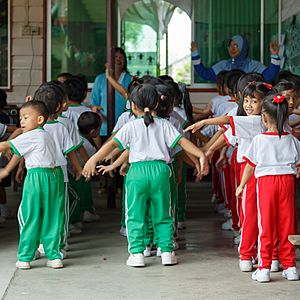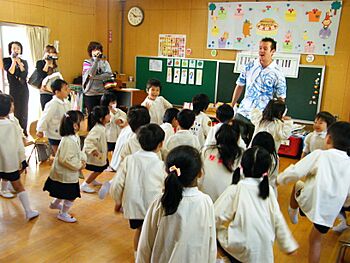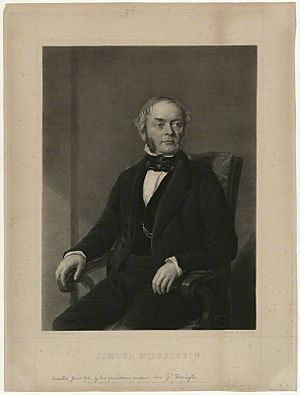Preschool facts for kids

A preschool (also called pre-primary school, play school, or nursery school) is a place where young children learn and play before they start primary school. These schools offer early childhood education and can be run by the government or by private groups. They might also get money from public funds. Most children attend preschool between the ages of 2 and 6 years old.
Contents
What Are Different Names for Preschools?
The names for early education places can be different depending on the country. In some European countries, "kindergarten" means formal education for very young children, and it might even be required before primary school.
Here are some common terms for schools for this age group:
- Pre-primary or creche: This can be for children from 6 weeks old up to 6 years old. It's a childcare service parents can use before primary school. These programs often happen in a nursery school.
- Nursery school (UK and US): This is a place for children from birth up to 5 years old. It includes preschool programs.
- Daycare (US): This is for children from birth up to about 2 and a half years old. It's usually held in a nursery school and is a childcare service.
- Preschool (US and UK): This is for children from 2 to 5 years old. Children often start when they are ready, which can include being potty trained. Preschool helps children learn how to talk with others and understand the world through play.
- Pre-K (or Pre-Kindergarten): This is for children aged 4 to 5 years old. It's a program in the USA to help more children get into pre-primary schools. It teaches more than just colors and numbers.
- Kindergarten (US): This is for children from 5 to 6 years old. It can be in a nursery school or some primary schools. In many parts of the world, it's the first step of formal schooling.
How Did Preschools Start?
Early Beginnings
Long ago, schools were mostly for children who already knew how to read and write at home. But people wanted to help orphans or children whose parents worked all day.
- In 1779, Johann Friedrich Oberlin and Louise Scheppler started an early center in France to care for and teach young children.
- In 1816, Robert Owen opened what was likely the first infant school in Scotland. He wanted children to learn good morals so they would be ready for work.
- Samuel Wilderspin opened his first infant school in London in 1819. He started many more and wrote books about his ideas. Play was very important in his system, and he is known for inventing the playground.
Spreading the Idea
- Countess Theresa Brunszvik opened the first "angel garden" (a type of preschool) in Hungary in 1828. She was inspired by these early examples.
- Friedrich Fröbel opened a "Play and Activity" institute in Germany in 1837. He later renamed it Kindergarten in 1840.
- Women trained by Fröbel helped open kindergartens all over Europe and the world.
- The first kindergarten in the United States opened in Wisconsin in 1856. Elizabeth Peabody started America's first English-language kindergarten in 1860.
- Head Start was the first government-funded preschool program in the US. It started in 1965 for families with lower incomes.
What Do Children Learn in Preschool?
The first few years of a child's life are very important for learning. During these early years, especially from ages 3 to 5, children can learn a lot. Their brains grow very quickly. Good preschools with well-trained teachers can help children learn better for a long time. This is especially true for children from disadvantaged backgrounds.
Preschool education usually covers these main areas:
- Personal, social, and emotional development: Learning how to get along with others and manage feelings.
- Communication, language, and literacy: Learning to talk, listen, and get ready to read and write.
- Mathematical development: Learning about numbers and shapes.
- Knowledge and understanding of the world: Learning about their surroundings.
- Physical development: Improving movement and coordination.
- Creative, expressive, and aesthetic development: Exploring art, music, and imagination.
Some studies suggest that "play-based" preschools are better than those that try to teach academic subjects too early. Playing with other children helps kids learn to make decisions, control their feelings, understand others, and make friends.
In 2022, about 68% of 4-year-olds in the United States went to preschool. Research shows that children who attend preschool often score higher in language and thinking tests. Preschool programs can also have long-term economic benefits, like higher earnings and more tax money.
Many different teaching methods are used in preschools, such as Montessori, Waldorf, Head Start, and Reggio Emilia approach.
What Do Preschool Programs Teach?
There's often a big discussion about what preschools should teach and how. Some people think preschools should focus on basic skills like reading and math. Others believe in a broader approach that helps a child's overall development. This includes their health, feelings, social skills, and communication. Most experts agree that a good curriculum should be flexible. It should allow teachers and parents to create learning plans that fit their children's needs.
How Preschools Differ Around the World
Preschool education helps children learn important cultural values. Because of this, preschools can be very different in various countries. However, one common goal is to help young children learn basic self-care tasks, like dressing themselves or using the toilet.
China
In China, early childhood education has changed a lot since the 1990s. The Chinese government is very interested in improving it. They have brought in ideas from Western countries, like Montessori and Reggio Emilia. A big goal is to help teachers improve their understanding of play and how to teach. They also want to make sure children with disabilities are included. Family involvement is also very important in China's preschool system.
India
In India, preschool education is mostly run by private companies. It's not yet officially recognized by the government. However, the National Education Policy (NEP) 2020 has highlighted the importance of early childhood care and education. It suggests a new schooling system that includes a strong focus on the foundational stage for children aged 3 to 8 years.
Ireland
Since 2010, Ireland has a law that allows all children between 3 years 2 months and 4 years 7 months to attend preschool for free. Before this, many children didn't go to preschool because it was too expensive. This new law greatly increased the number of children attending preschool, helping them prepare for primary school.
Japan

In Japan, a main goal of preschool is to help children develop social skills and feel like they belong to a group. Classes can be large, with up to 40 students. This encourages children to interact more with each other and less with the teacher. Children learn to work well in groups and to be cooperative and kind. Unstructured play time is highly valued. Children are often allowed to solve their own disagreements, even physical ones. Teachers focus on encouraging effort rather than just natural talent. They want all students to meet the same standards.
United Kingdom
In the UK, preschool education is partly funded by the government for children aged two to four. It can be offered by childcare centers, playgroups, or nursery classes within primary schools. There are also private options.
England
In England, children are entitled to 15 hours per week of free childcare or education after their third birthday. Preschools follow the Early Years Foundation Stage framework. This framework sets standards for how children learn and develop, and how they are kept healthy and safe. It helps children get ready for school. The program covers seven areas:
- Communication and language
- Physical development
- Personal, social, and emotional development
- Literacy
- Mathematics
- Understanding the world
- Expressive arts and design
United States
In the United States, preschool is usually voluntary. It aims to help children develop through planned activities. Preschools are available for children from ages three to five. They often follow similar learning plans as pre-kindergarten programs.
American preschools often focus on individuality. Children can choose from many activities, like drawing, playing house, or listening to stories. Teachers believe that "children's play is their work." They think that by choosing their play, children will meet their developmental needs. Teachers also encourage children to solve problems by talking and explaining what happened. They help children understand their actions before any consequences.
Cooperative Preschools
Cooperative preschools are common in America. They involve parents in the preschool environment. Parents often participate in the classroom and learn about early childhood education.
Head Start
Head Start and Early Head Start programs aim to prepare young children from low-income families for school. These programs serve children from birth to age five, pregnant women, and their families. Head Start started in 1965 to help children who might not have had many opportunities.
Head Start provides several services:
- Disabilities: All programs include children with disabilities.
- Education: The goal is to make sure children are ready for school. Activities focus on skills and knowledge.
- Family and Community Partnerships: Families and communities are involved in how the program is run.
- Health: The program provides health checks and teaches good health habits.
- Program Management: Focuses on providing high-quality services to children from low-income families.
See also
- Children's television series
- Daycare
- Education theory
- Heutagogy
- Pedagogy
- Poisonous pedagogy
- Pre-kindergarten
- Reggio Emilia approach
- Waldorf education
- Miriam Roth (1910–2005) – Israeli writer and scholar of children's books, kindergarten teacher, and educator
- Best Mother Toddler Program




